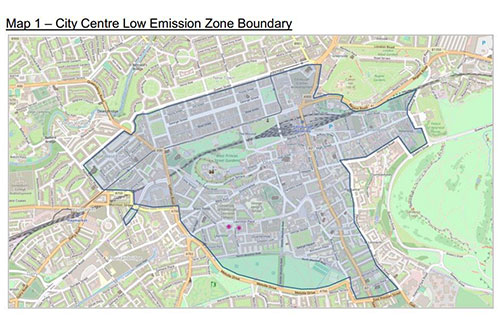Thursday July 18th 2019

Written by Local Democracy Reporter, David Bol
Edinburgh Council is proposing setting up a low emission zone to improve air quality and ease congestion on the Capital’s roads.
The city currently has six council designated air pollution zones, where air quality standards are not met.
What is a low emission zone?
A low emission zone (LEZ) is a designated area where certain vehicles that do not meet certain emission standards will face hefty fines.
The Transport Bill, currently being discussed in the Scottish Parliament, will give local authorities the powers to create, enforce, operate or revoke an LEZ in their area and to design the shape, size and vehicle scope of individual LEZs.
Why is a low emission zone being set up?
The Scottish Government is requiring Edinburgh, along with Glasgow, Aberdeen and Dundee, to set up a LEZ by the end of 2020 – when the Transport Bill is set to be written into law.
Low emission zones can help improve air quality and reduce congestion by removing the most polluting vehicles from roads.
Is there a need to improve air quality?
As well as being one of several measures to try and reduce the amount of traffic in Edinburgh, a LEZ could have major health benefits for residents and visitors.
Around 80 per cent of nitrogen oxide concentrations are directly linked to traffic emissions. Air pollution is believed to cause around 200 early deaths each year in Edinburgh.
What is being proposed?
The council is proposing two LEZs – one for the entire city and another for the city centre. The city centre LEZ proposals, which exclude Queen Street, Holyrood Road, Melville Drive and Haymarket, would lead to all vehicles that don’t meet emission standards facing hefty fines for entering the zone. But as the plans stand, cars will have until 2024 and possibly 2025 to meet standards – while buses and commercial vehicles will need to be upgraded by 2021.
A citywide LEZ, which under draft proposals does not include cars, will give buses and commercial vehicles until 2023 to comply with before being fined.
In order to qualify for the LEZ, cars will have to meet Euro 4 standards (vehicles sold after January 2006), diesel cars will need to meet Euro standards (vehicles sold after September 2015) – while heavy diesel vehicles will need to meet Euro 6/VI emission standards (generally those registered with the DVLA after 2014).
What if my car doesn’t meet the standards?
Vehicles that fail to meet the emissions standards are set to face hefty financial penalties, enforced by licence plate recognition cameras.
There will be different levels of fines, depending on the class of vehicle and whether drivers are repeat offenders. The penalties are expected to be set at a high level in order to deter non-compliance.
The Edinburgh draft proposals for LEZs is for the zones to be in operation 24 hours a day.
What happens next?
The city council’s public consultation on the draft proposals will close on Sunday 21 July. The results will be reported to councillors on the transport and environment committee in October.
The proposed final scheme will then be published in December. Once the Transport Bill and details around enforcement and legality are drawn up by Holyrood next year, the LEZ will come into force by the end of 2020 – although proposed grace periods will mean it won’t become operational until 2021.
To take part in the consultation, visit consultationhub.edinburgh.gov.uk
Tweet Share on Facebook